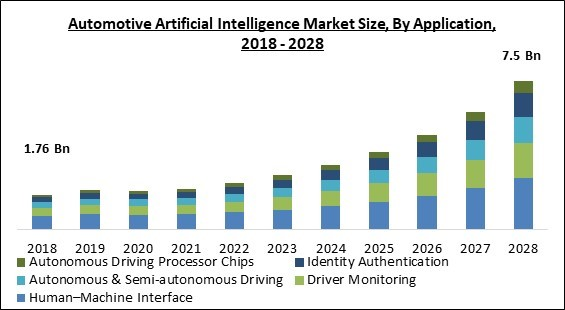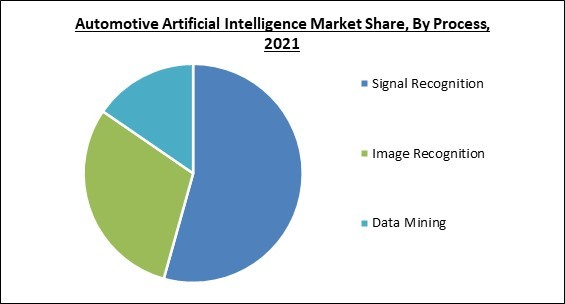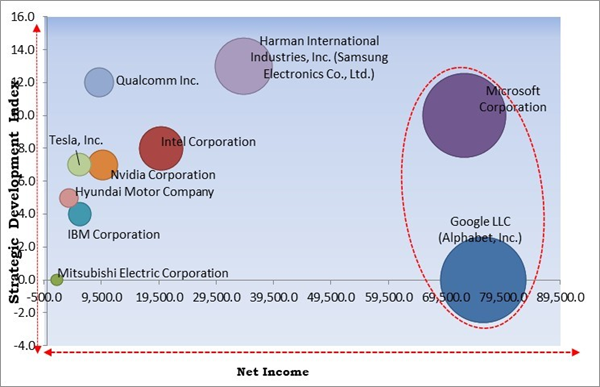The Global Automotive Artificial Intelligence Market size is expected to reach $7.5 billion by 2028, rising at a market growth of 21.5% CAGR during the forecast period.
The automotive sector has reaped the benefits of artificial intelligence and is among the primary industries employing AI to augment and imitate human actions. In addition, the advent of standards like adaptive cruise control (ACC), advanced driver assistance system (ADAS), and blind spot alert, as well as the increase in demand for comfort features, entice automotive providers to AI.
Autonomous cars are distinguished according to their degree of autonomy. Level 5 cars are completely autonomous, requiring no human involvement for safe operation. Nowadays, the significant proportion of autonomous vehicles on the road, like the Cadillac CT6 and Audi A8, belong to levels 2 and 3, are capable of performing at least two duties concurrently, and need a human driver to operate safely.
The major strategies followed by the market participants are Acquisitions. Based on the Analysis presented in the Cardinal matrix; Microsoft Corporation and Google LLC (Alphabet, Inc.) are the forerunners in the Automotive Artificial Intelligence Market. Companies such as Harman International Industries, Inc., Intel Corporation, Qualcomm Inc. are some of the key innovators in Automotive Artificial Intelligence Market.
The market research report covers the analysis of key stake holders of the market. Key companies profiled in the report include Microsoft Corporation, IBM Corporation, Google LLC (Alphabet, Inc.), Intel Corporation, Qualcomm Inc., Nvidia Corporation, Harman International Industries, Inc. (Samsung Electronics Co., Ltd.), Hyundai Motor Company, Mitsubishi Electric Corporation and Tesla, Inc.
The automotive sector has reaped the benefits of artificial intelligence and is among the primary industries employing AI to augment and imitate human actions. In addition, the advent of standards like adaptive cruise control (ACC), advanced driver assistance system (ADAS), and blind spot alert, as well as the increase in demand for comfort features, entice automotive providers to AI.
Autonomous cars are distinguished according to their degree of autonomy. Level 5 cars are completely autonomous, requiring no human involvement for safe operation. Nowadays, the significant proportion of autonomous vehicles on the road, like the Cadillac CT6 and Audi A8, belong to levels 2 and 3, are capable of performing at least two duties concurrently, and need a human driver to operate safely.
COVID-19 Impact Analysis
To mitigate the effects of the COVID-19 pandemic, governments throughout the world were compelled to institute strict lockdowns and demand social isolation. As a result, the demand for new automobiles declined significantly. In addition, the availability of raw materials decreased, production slowed, and worldwide supply networks were disrupted. The automobile industry's losses have impeded the implementation of cutting-edge cybersecurity technologies. However, it is projected that the use of automotive artificial intelligence would expand over time owing to the growing demand for connected vehicles and the ongoing global vaccination campaign.Market Growth Factors:
Growing need for customer experience and efficiency of automobiles
Human-machine interface (HMI) solutions for the automobile sector are now easier to handle and manage, hence boosting the user experience. A user may operate applications such as music systems, car lighting, and infotainment systems with such technologies. Due to the rising demand for better customer experience and additional features, the percentage of a vehicle's cost devoted to its electronics system has climbed from 1-2% to 8-12%.Significant likelihood of in-car payments
Among the most recent innovations, in-car payments are intended to change the ways in which consumers pay for parking or tolls, refuel, and potentially even go grocery shopping. Open Banking, which allows consumers to pay immediately from their bank and eliminates friction and security concerns associated with their payment trip, might be utilized to develop in-car wallets as well as payment systems. By simplifying transaction fees and enhancing the entire user experience, third-party payment networks might be eliminated.Marketing Restraining Factor:
Surge in the overall cost of vehicle
Autonomous cars are projected to be expensive due mostly to the commercialization of new technology systems. The majority of innovative technology are included into luxury and premium automobiles, which have a restricted client base due to their high price. Therefore, a high car price is likely to inhibit market expansion. In comparison to semi-autonomous cars, the demand for costly autonomous vehicles is predicted to be mild.Application Outlook
On the basis of application, the automotive artificial intelligence market is divided into Human-Machine Interface, Autonomous & Semi-autonomous Driving, Identity Authentication, Driver Monitoring and Autonomous Driving Processor Chips. Identity Authentication segment recorded a significant revenue share in the automotive artificial intelligence market in 2021. Authentication is the procedure of confirming the identity of a known user in order to grant access to an account, location or device. In addition, authentication of identity is employed when a person's authenticity must be demonstrated. In this situation, previous personal information provided is compared.Process Outlook
Based on Process, the automotive artificial intelligence market is classified into Signal Recognition, Image Recognition and Data Mining. Signal Recognition segment garnered the maximum revenue share in the automotive artificial intelligence market in 2021. Signal recognition is a technique for producing outcomes using spoken, visual patterns, and sound. The signals often relate to the speech or sound produced by a machine or a person, which may be identified by natural language processing (NLP) devices and used to provide a result. Signals are the unprocessed data that AI systems must be able to analyze in order to generate, comprehend, and make intelligent judgments.Technology Outlook
By technology, the automotive artificial intelligence market is segmented into Deep Learning, Machine Learning & Computer Vision, Context- aware Computing, and Natural Language Processing. Machine Learning & Computer Vision segment recorded a significant revenue share in the automotive artificial intelligence market in 2021. Machine learning enables automobiles to assess and learn from various driving scenarios, therefore reducing accidents and making them safer and more fuel-efficient. It can generate precise models that could direct future activities and instantly uncover trends at a scale that was not before possible.Offering Outlook
On the basis of offering, the automotive artificial intelligence market is bifurcated into Hardware and Software. The software segment procured the maximum revenue share in the automotive artificial intelligence market in 2021. This is due to the numerous advancements in AI software and software development kits. To actualize automotive applications, AI systems require several forms of software, including application programme interfaces for language, audio, vision, and sensor data, as well as machine learning techniques.Component Outlook
By component, the automotive artificial intelligence market is fragmented into Graphics processing unit (GPU), Microprocessors (Incl. ASIC), Field Programmable Gate Array (FPGA), Memory & Storage systems, Image Sensors, Biometric Scanners and Others. Graphics processing unit (GPU) segment acquired the maximum revenue share in the automotive artificial intelligence market in 2021. GPUs are gaining importance in the fast-emerging disciplines of autonomous driving and advanced driver assistance systems (ADAS). For real-time processing and analysis of sensor data, ADAS platforms can utilize the GPU's graphical compute power.Regional Outlook
Region-wise, the automotive artificial intelligence market is analyzed across North America, Europe, Asia Pacific and LAMEA. North America emerged as the leading region in the automotive artificial intelligence market with the highest revenue share in 2021. The quick growth of autonomous vehicle technology and the stringent government laws governing road safety are projected to promote moderate growth in artificial intelligence in the automotive industry in this region.Cardinal Matrix-Automotive Artificial Intelligence Market Competition Analysis
The major strategies followed by the market participants are Acquisitions. Based on the Analysis presented in the Cardinal matrix; Microsoft Corporation and Google LLC (Alphabet, Inc.) are the forerunners in the Automotive Artificial Intelligence Market. Companies such as Harman International Industries, Inc., Intel Corporation, Qualcomm Inc. are some of the key innovators in Automotive Artificial Intelligence Market.
The market research report covers the analysis of key stake holders of the market. Key companies profiled in the report include Microsoft Corporation, IBM Corporation, Google LLC (Alphabet, Inc.), Intel Corporation, Qualcomm Inc., Nvidia Corporation, Harman International Industries, Inc. (Samsung Electronics Co., Ltd.), Hyundai Motor Company, Mitsubishi Electric Corporation and Tesla, Inc.
Strategies deployed in Automotive Artificial Intelligence Market
Partnerships, Collaborations and Agreements:
- Sep-2022: Qualcomm Technologies joined hands with Mercedes-Benz, a German luxury and commercial vehicle automotive brand. This collaboration aimed to use Snapdragon Digital Chassis solutions to bring new and most digitally advanced capabilities to upcoming Mercedes-Benz vehicles.
- Jul-2022: HARMAN International joined hands with the ARD Audiothek app. Under this collaboration, the ARD Audiothek app would be accessible in the HARMAN Ignite Store, which is a connected vehicle platform that allows automakers to design, maintain, and operate their own in-vehicle app store.
- Jul-2020: Microsoft China came into a partnership with Human Horizons, a maker of electric cars under the HiPhi brand, and develops autonomous driving technology. This partnership aimed to develop an on-board AI assistant, HiPhiGo, for Human Horizons’ premium smart all-electric vehicles, HiPhi.
Product Launches and Product Expansions:
- Feb-2022: Qualcomm Technologies launched new and improved solutions to its significantly expanding automotive technology portfolio. By improving its Snapdragon Digital Chassis connected vehicle platforms, Qualcomm Technologies released a feature for Snapdragon Car-to-Cloud Services, Connectivity-as-a-Service. This advancement would offer a transformative, scalable, comprehensive portfolio of solutions via the Snapdragon Digital Chassis.
- Jan-2022: Qualcomm Technologies launched a new addition to the Snapdragon Ride Platform portfolio, with the Snapdragon Ride Vision System. This system is an open, scalable, and modular computer vision software stack developed on a four-nanometer (4nm) process technology system-on-chip (SoC) built for an optimized deployment of front and surround cameras for advanced driver assistance systems (ADAS) and automated driving (AD).
- Aug-2021: Tesla released a custom chip for training artificial intelligence networks in data centers. This D1 chip is a part of Tesla’s Dojo supercomputer system, which utilizes a 7-nanometer manufacturing procedure, with 362 teraflops of processing power. The chips would assist train models in identifying a range of items from video feeds gathered by cameras inside Tesla vehicles.
- Apr-2021: NVIDIA unveiled NVIDIA DRIVE Atlan, its next-generation AI-enabled processor for autonomous vehicles. This solution would help in delivering more than 1,000 trillion operations per second (TOPS) and target automakers’ 2025 models. DRIVE Atlan would comprise NVIDIA’s next-generation GPU architecture, and new Arm CPU cores, along with its deep learning and computer vision accelerators.
- Jan-2021: Hyundai Motor Group introduced the ‘DAL-e’, a highly advanced customer service robot. This robot is capable of independently communicating with people by utilizing precise recognition capabilities and mobility functions. This robot is equipped with state-of-the-art AI technology for facial recognition and an automatic communication system based on a language-comprehension platform.
Acquisitions and Mergers:
- Sep-2022: HARMAN International acquired CAARESYS, an Israel-based company. This acquisition aimed to enable HARMAN to become the market leader in-cabin radar sensing technology and radar-enabled features, which would rapidly combine into the products.
- Jul-2022: IBM took over Databand, a startup developing an observability platform. This acquisition aimed to deliver the customers and partners with the technology they require to offer trustworthy data and AI at scale.
- Apr-2022: Qualcomm Incorporated took over Arriver from SSW Partners. This acquisition aimed to improve Qualcomm Technologies' capability to provide open, fully integrated, and competitive Advanced Driver Assistance System (ADAS) solutions to automakers and Tier-1 suppliers at scale.
- Mar-2022: Microsoft took over Nuance Communications, a leader in conversational AI and ambient intelligence across industries. This acquisition aimed to assist providers in providing more affordable, efficient, and accessible healthcare, and assist companies in every industry develop more customized and meaningful customer experiences.
- Feb-2022: HARMAN International took over Apostera, a Germany-based automotive technology company. This acquisition aimed to integrate Computer Vision, Machine Learning, Augmented Reality, and sensor fusion into a hardware-agnostic software platform. By effortlessly combining AR with the physical environment, Apostera’s mixed reality solution would support the goal of the company and transform any display in the car into a richly contextual experience.
- Nov-2020: Intel completed the acquisition of Cnvrg.io, a full-stack data science platform. This acquisition aimed to strengthen Intel's machine learning and AI operations. Along with that, Intel’s acquisition of Cnvrg would assist it to continue to develop a complete portfolio of AI tools for developers to support its next-gen hardware.
- Sep-2020: NVIDIA acquired Arm Limited from SBG. This acquisition aimed to bring NVIDIA’s AI computing platform together with Arm’s vast ecosystem to develop the premier computing company for the era of AI, boosting innovation along with expanding into large, high-growth markets.
Scope of the Study
Market Segments Covered in the Report:
By Application
- Human-Machine Interface
- Driver Monitoring
- Autonomous & Semi-autonomous Driving
- Identity Authentication
- Autonomous Driving Processor Chips
By Process
- Signal Recognition
- Image Recognition
- Data Mining
By Technology
- Deep Learning
- Machine Learning & Computer Vision
- Natural Language Processing
- Context- aware Computing
By Offering
- Software
- Hardware
By Component
- Graphics Processing Unit (GPU)
- Microprocessors (Including ASIC)
- Field Programmable Gate Array (FPGA)
- Memory & Storage Systems
- Image Sensors
- Biometric Scanners
- Others
By Geography
- North America
- US
- Canada
- Mexico
- Rest of North America
- Europe
- Germany
- UK
- France
- Russia
- Spain
- Italy
- Rest of Europe
- Asia Pacific
- China
- Japan
- India
- South Korea
- Singapore
- Malaysia
- Rest of Asia Pacific
- LAMEA
- Brazil
- Argentina
- UAE
- Saudi Arabia
- South Africa
- Nigeria
- Rest of LAMEA
Key Market Players
List of Companies Profiled in the Report:
- Microsoft Corporation
- IBM Corporation
- Google LLC (Alphabet, Inc.)
- Intel Corporation
- Qualcomm Inc.
- Nvidia Corporation
- Harman International Industries, Inc. (Samsung Electronics Co., Ltd.)
- Hyundai Motor Company
- Mitsubishi Electric Corporation
- Tesla, Inc.
Unique Offerings from the Publisher
- Exhaustive coverage
- The highest number of market tables and figures
- Subscription-based model available
- Guaranteed best price
- Assured post sales research support with 10% customization free
Table of Contents
Chapter 1. Market Scope & Methodology
Chapter 2. Market Overview
Chapter 3. Competition Analysis - Global
Chapter 4. Global Automotive Artificial Intelligence Market by Application
Chapter 5. Global Automotive Artificial Intelligence Market by Process
Chapter 6. Global Automotive Artificial Intelligence Market by Technology
Chapter 7. Global Automotive Artificial Intelligence Market by Offering
Chapter 8. Global Automotive Artificial Intelligence Market by Component
Chapter 9. Global Automotive Artificial Intelligence Market by Region
Chapter 10. Company Profiles
Companies Mentioned
- Microsoft Corporation
- IBM Corporation
- Google LLC (Alphabet, Inc.)
- Intel Corporation
- Qualcomm Inc.
- Nvidia Corporation
- Harman International Industries, Inc. (Samsung Electronics Co., Ltd.)
- Hyundai Motor Company
- Mitsubishi Electric Corporation
- Tesla, Inc.
Methodology

LOADING...











